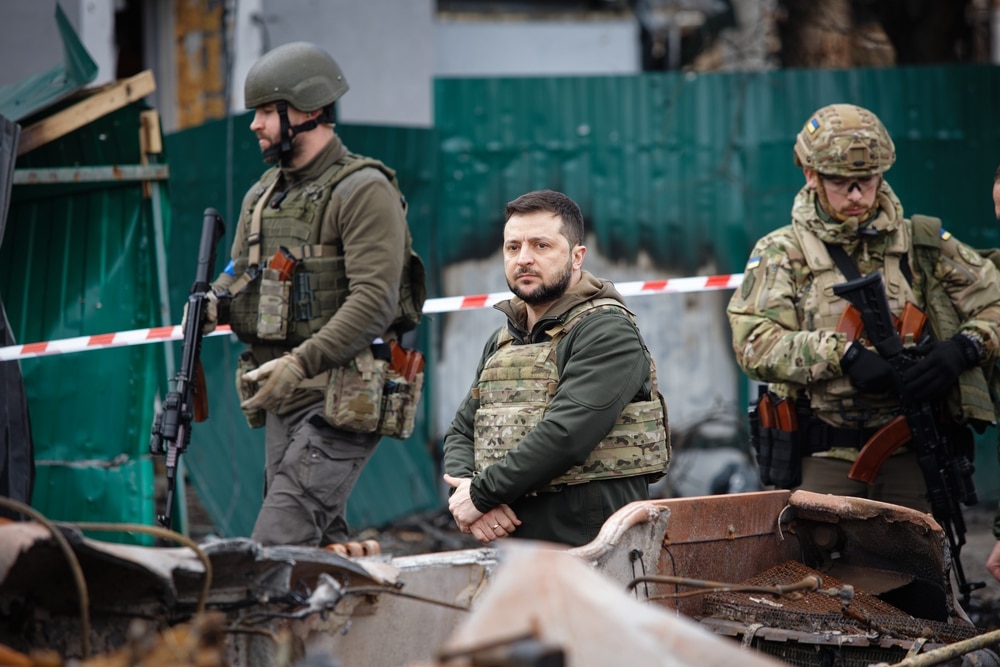There were probably many reasons why Ukraine’s President Volodymyr Zelensky fired Ukraine’s popular commander in chief of the armed forces, Valerii Zaluzhny, on February 8, but one of the biggest seems to have been a disagreement over how to go forward in a war that seemed to have overwhelmingly turned against them. Zelensky spoke of a need for “the same vision of the war,” and Zaluzhny said “a decision was made about the need to change approaches and strategy.”
When the war began, Zelensky said that Ukraine “will definitely win” but stressed life over land. “Our land is important, yes, but ultimately it’s just territory.” He said that “Victory is being able to save as many lives as possible. Yes, to save as many lives as possible, because without this nothing would make sense.”
But actions speak louder than words. Zelensky began to define victory as the reclamation, not only of land lost during the war, but of Crimea and all of Ukraine’s pre-2014 territory. Zelensky insisted that Ukraine stay on the offensive. He insisted on moving forward, “Whether it’s by a kilometer or 500 meters, but forward every day.”
Zaluzhny saw Zelensky’s strategy of fighting for Bakhmut and Avdiivka at any cost as a strategic disaster that was costing Ukraine too much in weapons and in lives. Zaluzhny argued for preserving lives over forfeitable territory, lest Ukraine lose its land and its army.
In General Oleksandr Syrsky, Zelensky found the commander who would execute his vision and carry out his orders. Syrsky fought the Battle of Bakhmut. His performance there, and in other battles, gave him the reputation of a commander who is willing to give orders that lead to little real gain and lots of real loss of life. “Some soldiers say his orders are unreasonable, at times sending men to their obvious deaths,” The Washington Post reports. According to The Economist, he “has a reputation for being willing to engage the enemy, even if the cost in men and machines is high.” His reported willingness to put “his men in danger to reach his military goals” has earned him the nicknames “Butcher” and General 200, 200 being the code for a soldier’s corpse. Syrsky is also seen as being a commander who is close to Zelensky and who will not question his orders.
The replacement of Zaluzhny by Syrsky signals Zelensky’s intent to push ahead with the suicidal war of attrition and fight for every inch of land despite the cost in lives.
Aware of the optics of the choice in the public and, perhaps especially in the armed forces, Kiev assuaged the perception of Syrsky as “being indifferent to military casualties.” In his first statement as commander in chief, Syrsky said, “The lives and well-being of our servicemen have always been and remain the main asset of the Ukrainian army.”
But, again, actions speak louder than words. General Syrsky’s first words were about protecting the lives of his men, but his first actions were about fighting for every inch of territory.
On February 11, just three days after the change in command, Syrsky ordered the reinforcement and defence of Avdiivka, a strategic town that faced imminent loss to the Russian army and enormous loss of Ukrainian lives. Zaluzhny would have withdrawn his troops, preserved lives and moved the front to more defensible positions.
Syrsky deployed the 3rd Separate Assault Brigade, one of the best armed and trained and most successful brigades in the Ukrainian Armed Forces.
It did not go well. It went exactly as Zaluzhny said it would, and Syrsky was forced to respond exactly as Zaluzhny had said they should. But now the response was carried out in disarray instead of in an orderly, planned fashion. Perhaps Zelensky should have stuck with Zaluzhny.
In sending in reinforcements instead of retreating, Syrsky said the “goal of our operation is to exhaust the enemy, inflict maximum losses on him.” The opposite happened.
Less than a week later, on February 17, Syrsky announced the withdrawal of Ukrainian troops from Avdiivka. “Based on the operational situation around Avdiyivka, in order to avoid encirclement and preserve the lives and health of servicemen,” he said, “I decided to withdraw our units from the city and move to defense on more favorable lines…The life of military personnel is the highest value.” That’s exactly what Zaluzhny advised Zelensky to do.
But the situation was worse than at first reported. Zaluzhny would have preplanned the retreat and executed it according to a plan. Zelensky and Skysky’s stubbornness turned the already costly loss into a disaster.
CNN at first reported that “Ukrainian forces are currently conducting a relatively controlled withdrawal from Avdiivka.” There were “indications,” though, “that not all Ukrainian units were able to escape an ever-tightening noose.” Though “the withdrawal was carried out in accordance with the plan that had been developed…a number of Ukrainian servicemen were taken prisoner at the final stage of the operation, under pressure from the enemy’s superior forces.”
Three days later, the situation was becoming clearer. Senior Western officials, The New York Times reported, now say that “Hundreds of Ukrainian troops may have been captured by advancing Russian units or disappeared during” what they now call, “Ukraine’s chaotic retreat from the eastern city of Avdiivka.” The Times was now calling it “a devastating loss.”
And hundreds may have been an understatement. Further down in the article, the Times reports that “soldiers with knowledge of Ukraine’s retreat estimated that 850 to 1,000 soldiers appear to have been captured or are unaccounted for.” There are unconfirmed reports of even higher numbers of dead and wounded.
That may not have happened under Zaluzhny, who long ago conceded that Avdiivka would fall and would have preplanned the retreat. Some Ukrainian soldiers and Western officials say “the Ukrainian withdrawal was ill-planned and began too late,” according to the Times. They say that “a failure to execute an orderly withdrawal, and the chaos that unfolded Friday and Saturday as the defenses collapsed, was directly responsible for what appears to be a significant number of soldiers captured.”
Suddenly, the 3rd Separate Assault Brigade was not assaulting but desperately trying “to cover the retreat.” The retreat was chaotic: “…some units pulled back before others were aware of the retreat. That put the units left behind at risk of encirclement by the Russians.”
But the true story may be even worse. Military analyst Stephen Bryen reports that the disaster may have begun before the reinforcements even arrived at Avdiivka. Some of the brigades Syrsky brought in gathered and organized in the nearby town of Selydove. Bryen says the Russian military discovered they were there and struck with missiles. Between 1,000 and 1,500 Ukrainian soldiers were reportedly killed.
Bryen says that when the 3rd Separate Assault Brigade arrived in Avdiivka, they found a desperate situation. They reportedly discarded Syrsky’s orders and retreated. Some reportedly surrendered. Syrsky then announced the troop withdrawal and the fall of Avdiivka.
Zelensky’s choice of Syrsky over Zaluzhny was, in part, the choice to maintain the course of a war of attrition to hold and retake all Ukrainian territory. Syrsky’s first orders fulfilled that choice in Avdiivka. It went exactly as Zaluzhny said it would but worse because Zelensky and Syrsky tried to defy the battlefield reality that Zaluzhny recognized. Perhaps Zelensky should have stuck with Zaluzhny.








